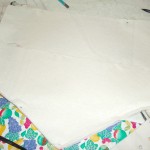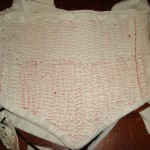![]()
I pad-stitched my layers of bombast (warm and natural cotton quilt batting) together, leaving the seam allowances intact. I don’t know if the stitching will cause the layers to shrink, and I can always trim them down later. I am only padding out the front of the bodice, one layer going over the bust and the other layer stopping at the underbust.
The idea is to fill in some of the space where the bust meets the torso. This is also the area where I was getting wrinkles when just using a layer of twill and buckram. Pad-stitching will keep the layers of batting from shifting over time. In the end I had a gently curving layers of batting.

It would have been faster if I zig-zagged it on the sewing machine, but the end result would have been a flat quilted layer.
The batting layers secured I sat down with a leather needle and a thimble and started pad-stitching through all the layers to secure the batting to the bodice. This took a few days as punching through twill, buckram, batting, and muslin can wear out your fingers.
The end result however was worth it.
The layers of batting and pad-stitching stiffen the bodice just enough that it remains smooth yet slightly flexible. It does not sit flat when on the table, but rather curves and holds its own shape.

